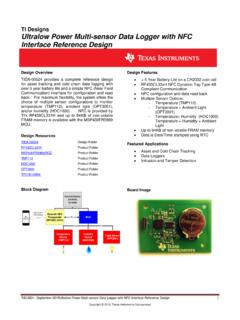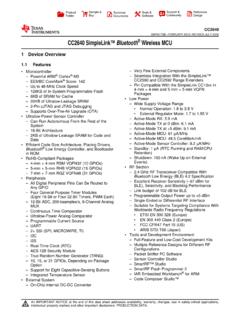Transcription of Project Code: APM-BIOCHEM-ANALYZER-2014 ADI …
1 Project Code: APM-BIOCHEM- analyzer - 2014 . ADI biochemistry analyzer solutions biochemistry analyzer and Typical Architecture Biochemical analyzers use many electrochemical and optical techniques to analyze blood, urine, cerebral spinal fluid, and other biological samples. The most widely used techniques are optically based measurements, and examples include colorimetric, absorption, spectrometric, and fluoroscopic detection methods. These processes can measure chemicals such as antigens, molecules, and proteins in body fluids. These techniques are widely used at all levels of hospitals, clinics, epidemic prevention stations, and family planning service providers because of their fast measurement ability, high sensitivity, and accuracy when detecting even small doses of chemicals.
2 Biochemical analyzers are complex systems that are composed of an optical engine consisting of light sources, detectors and other optical elements, sample movement/fluidics, automation control and processing, power management, and environmental monitoring and control (temperature, pressure, humidity). For greater efficiency, biochemical analyzers have become highly automated. This technology automates sample loading, tube cleaning, mechanical control, and data processing. The operator just needs to insert the sample for analysis, choose the program, and start the instrument. Laboratory biochemical analyzers could be classified by processing capacity into large (600+ samples per hours), middle (300-600 samples per hours), and small (below 300 samples per hour) sizes.
3 They can also me characterized by laboratory based or point of care testers (POCT), which are deployed near patients for faster test turnaround time. biochemistry analyzer Design Considerations and Major Challenges System integration is complex because a biochemical analyzer is composed of different technologies like a spectrophotometer, electrochemistry modules (ISE, ph), fluidic and sample handling features, automatic control, and data processing systems. Measurement speed is very important. Reagent volume control is important for cost and consistency. Optical system control and precision is critical in system. Spectrophotometer.
4 Need low bias, high ZIN, low noise, and low offset op amps for I/V converters in photodiode input. Fast, high precision, simultaneous sampling ADC. Low noise and stable power supply. Low noise, stable light source. Temperature control is very important for reagent and chemical reaction. Enzymes are sensitive to temperature fluctuations. Reaction rates are very sensitive to temperature. The general temperature range is body temperature, and accuracy is up to C. Heat/cooler equipment is sometimes integrated for smooth and stable temperature control. Automation control is necessary to improve executive efficiency. Accurate step and position control.
5 Multi axis motor motion control for sample movement and transfer inside instrument. Accurate liquid level measurement. Pressure detection to detect blockages. Accurate and fast sample loading and cleaning. Data processing and classification. High speed processor for multichannel data process. DSP to accelerate complex analysis. Provide an inspection report as soon as possible. Total solutions from ADI. ADI provides an extensive selection of amplifiers for I/V conversion, filter design, signal conditioning, and ADC drivers, as well as providing data conversion, signal processing, and power management solutions to maximize product quality and reliability for the biochemistry analyzer application.
6 In addition, ADI. provides evaluation boards, simulation tools, and applications expertise to support customer design and development efforts. Main Signal Chain The biochemistry analyzer is a very complex device that contains various technologies. The signal chain below diagrams the overall system, then provides an overview of each subsystem. SOFTWARE AND GUI. ADI. PROVIDED. PROCESSOR AND NOT ADI. POWER MANAGEMENT. CONTROLLER SYSTEM. LEGEND. SAMPLE LOAD AND TEMPERATURE CONTROL. OPTICAL SYSTEM. CLEANING SYSTEM SYSTEM. Figure 1. System diagram LIGHT PHOTO I/V. SAMPLE FILTER ADC. SOURCE DETECTOR CONVERTOR. TEST TUBE ADI. PROVIDED.
7 PROCESSOR. NOT ADI. LEGEND. LIGHT. FILTER DAC. DRIVER. Figure 2. Spectrophotometer subsystem Notes: The signal chains above are representative of a biochemistry analyzer system. The technical requirements of the blocks vary, but the products listed in the table are representative of ADI's solutions that meet some of those requirements. 2 | ADI biochemistry analyzer solutions I/V Convertor Filter Mux DAC ADC Processor Light Driver AD549/AD8605/ AD8625/AD8626/ ADAS1126/ADAS3023/ ADuCM350/ADuCM360/. AD8606/AD8608/ ADA4051-1/ADA4051-2/ AD7982/AD7960/ ADUC7021/ADUC7022/ ADP8866/ADP8140/. ADG1408/ADG1434/ AD5693R/AD5686R/. AD8661/AD8662/ ADA4528-1/ADA4528-2/ AD7606/AD7190/ ADUC7023/ ADP2386/ADP2503/.
8 ADG1208/ADG509F AD5780/AD9122. AD8664/ADA4627-1/ ADA4638-1/ADA4627-1/ AD7176-2/AD7264/ ADSP-BF512F/ AD5820. ADA4637-1 ADA4092-4/ADA4610-2 AD7862 ADSP-BF527C. Part Number Description Benefits I/V Converter The AD549 is a monolithic electrometer operational amplifier with very low input bias current; input Ultralow input bias current operational amplifier;. AD549. offset voltage and input offset voltage drift are laser trimmed for precision performance ultralow current and voltage noise The AD8605 is a single rail-to-rail input and output, singlesupply amplifier; it feature very low offset AD8605 voltage, low input voltage and current noise, and wide signal bandwidth; it use the ADI patented Precision, low noise, CMOS, RRIO op amp DigiTrim trimming technique, which achieves superior precision without laser trimming Filter The AD8625 is a precision JFET input amplifier; it features true single-supply operation, low power AD8625 consumption, and rail-to-rail output.
9 The outputs remain stable with capacitive loads of over 500 pF; Precision, low power, single-supply, JFET amplifier the supply current is less than 630 A/amp The ADA4627-1 is a wide bandwidth precision amplifier featuring low noise, very low offset, drift, and 36 V, 19 MHz, low noise, low bias current, JFET. ADA4627-1. bias current; the parts operate from 5 V to 15 V dual supply op amp Mux The ADG1408 monolithic iCMOS analog multiplexer comprises eight single channels; the ADG1408. 4 , 4-channel/8-channel 15 V, 12 V, 5 V. ADG1408 switches one of eight inputs to a common output, as determined by the 3-bit binary address lines, A0, CMOS multiplexer A1, and A2.
10 The ADG508F is a CMOS analog multiplexer and it comprises eight single channels; this multiplexer 8-channel/4-channel fault-protection ADG509F. provides fault protection analog multiplexer DAC. Tiny 16-bits nanoDAC+ , with 2 (16-bits) LSB INL;. AD5693R The AD5693R is a low power, single-channel, 16-bit buffered voltage out DAC. 2 ppm/ C reference The AD5686R nanoDAC+ is a quad, 16-bit, rail-to-rail, voltage output DAC; the device includes a Quad, 16-bit nanoDAC+ with 2 ppm/ C on-chip AD5686R V, 2 ppm/ C internal reference (enabled by default) and a gain select pin giving a full-scale output of reference and SPI interface V (gain = 1) or 5 V (gain = 2).











